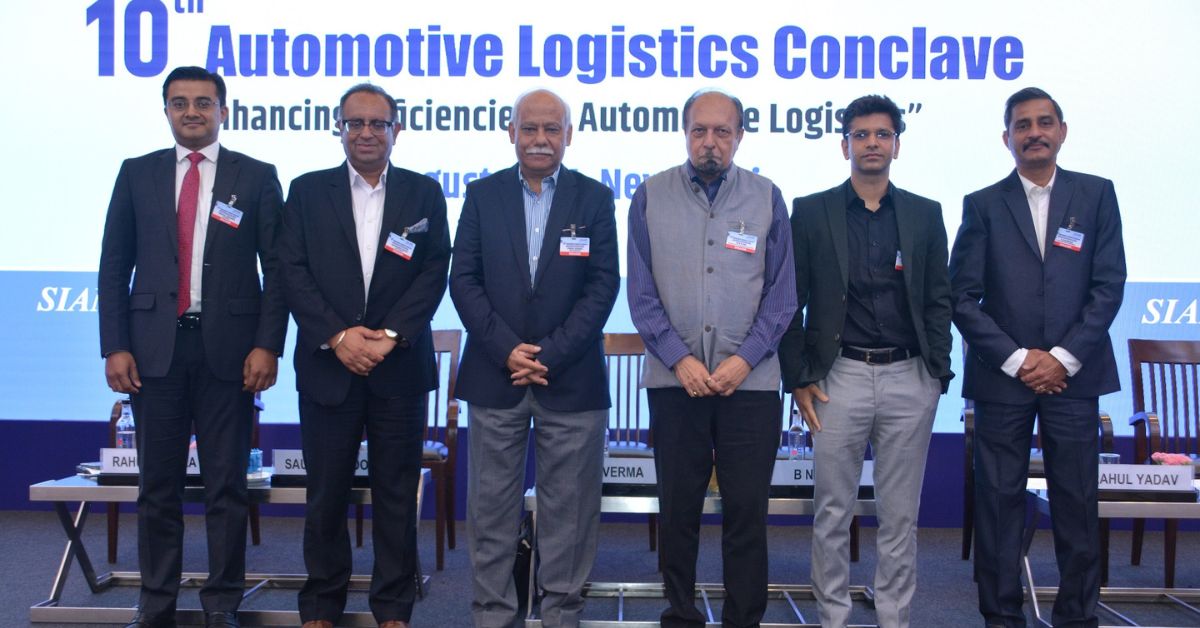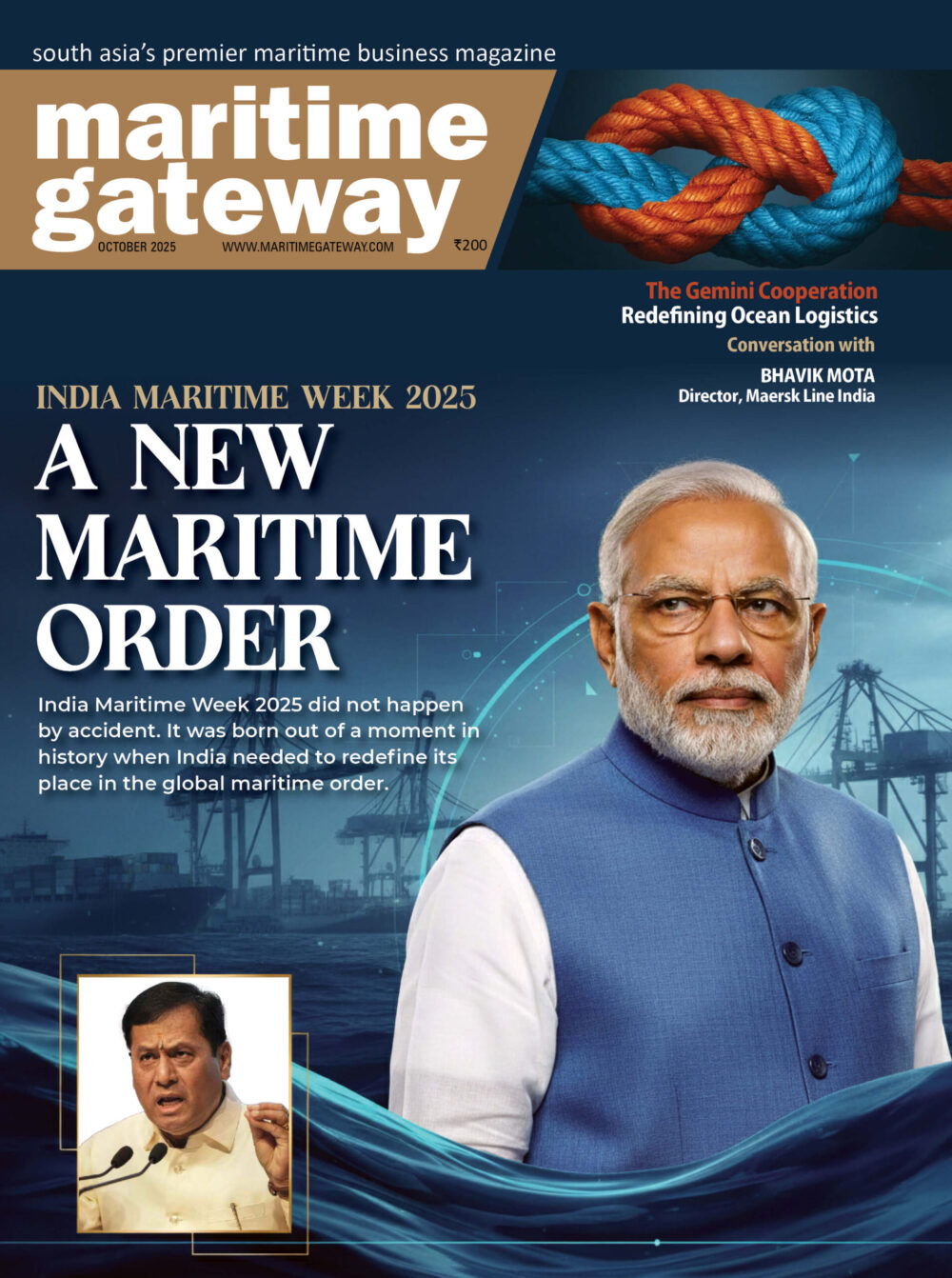The Society of Indian Automobile Manufacturers (SIAM) held its 10th Automotive Logistics Conclave in the capital. SIAM is the apex national body representing all primary vehicle and vehicular engine manufacturers in India. The theme of the conclave was Enhancing Efficiencies in Automotive Logistics. The conclave focused on new technologies, efficiency, and sustainability.
The opening session of the conclave dwelt on the pertinent subject of the Future of Automotive Logistics: Innovations Driving Logistics Efficiency. The panel consisted of Rahul Mishra, Partner Kearney as the moderator; B N Puri, Director, Asian Institute of Transport Development (AITD); Saurabh Sood, President, and Managing Director, GATX India Private Limited (GIPL); Rahul Yadav, CEO, Axestrack; S Khannan, Head of Outbound Logistics, TVS Motor Company and Prem Verma, Director PVS Services, Former Chairman, SIAM Logistics Group.
Saurabh Sood said that GATX was an asset management company that dealt with rolling stock, and its expertise lay in the design and engineering side, focussing on designing wagons with the most outstanding efficiency in terms of operational and environmental sustainability. Not just on the design and engineering side but also in bringing IT solutions, AI, and machine learning. Likewise, they had started an initiative in India, where all the wagons that GATX will be supplying will be GPS-enabled. At the primary level, it can provide tracking and gradually move into predictive maintenance of wagons. Since the vehicles have become larger in dimensions, they have manufactured bigger wagons to exploit the maximum dimensions approved by the Indian Railways. They have introduced articulated connectors, a technology that was introduced in India for the first time.
Rahul Yadav, CEO of Axestrack, provided digital solutions to transform the transportation and logistics industry across industries. They offer a digital solution called the connected operating system. This layer acts above the primary telematics, FFS, CMS and ERP layers. It relates to every other layer in the system, including every other stakeholder such as driver, fleet owner, transport agent, consignor, consignee, etc. They have introduced a new concept, the Managed Control Tower (MCT), which revolutionises supply chain management by integrating advanced technologies and expert analysis to enhance responsiveness and resilience.
The theme of the first session was Smart Logistics Solutions. The panellists were Subash Chandra Karol, Director, DPIIT, Government of India; KC Sharma, Chief Engineer, Ministry of Transport & Highways; Anil Chhikara, Advisor Transport, Assam Transport Department, Vipul Nanda, Chairman & Managing Director, Pallia Trans Logistics, Herman Sips, Senior Strategic Adviser, Smart Freight Centre, Yash Pal Sachar, Vice President, Corporate Affairs, Ashok Leyland Limited, P Rajagopi, Operating Officer – Logistics Planning & Control, Honda Motorcycle and Scooters India Pvt Ltd.
Subash Chandra Karol, Director of DPIIT, said that logistics costs were around 10% of the overall manufacturing cost in India. In the coming few years, it was necessary to bring it down to the global figure of 7 to 8 %.
The government was focusing on two aspects. One is to improve the connectivity infrastructure. So, for that, the government launched a very ambitious initiative called PM Gati Shakti. This platform facilitated faster infrastructure planning for roads, railways, ports, and other logistics infrastructure. All types of data required for faster decision-making were available on this platform. These are GIS-based platforms.
Apart from this, the government has set up an institutional mechanism by which all the infra ministries sit together during the planning stage. The congregation of the various ministries adds value to the planning and allows any problems encountered with other ministries to be resolved at that stage.
Then, there is the mechanism called the Project Monitoring Group, wherein the Prime Minister monitors infrastructure implementation at various levels. Because of this monitoring, the Government could construct more than 15 kilometres of track per day compared to 1 to 2 km per day, earlier. The government also endeavoured to improve the logistics performance index from 38 to 25.
KC Sharma, Chief Engineer, Ministry of Transport & Highways, responded to the question of eliminating or reducing road accidents on the highways. The government has developed Integrated Road Accident Database (iRAD) software. Here, they try to identify the number of accidents that take place. This software can capture all the relevant data and the potential black spots on the roads. The purpose was to address all the black spots. The IT-based system was being used for capturing the accident spot data using the mobile app. This data can then be utilised for various purposes, such as finding the causes of the accidents, remedial measures to improve the road infrastructure, and recording the accident data for police, health services, and other concerned departments. The nearest hospital is informed, and the patient can get cashless treatment for sustained injuries.
Regarding the facilities for drivers, Anil Chhikara, Advisor Transport, Assam Transport Department, said that the Government came up with a scheme called Accredited Driving Training Center. Here, the driving skill of the person will be evaluated without human intervention. The results will be uploaded to the SARATHI site under the aegis of the Ministry of Road Transport and Highways. This way, the interaction with the Regional Transport Office (RTO) can be reduced or eliminated. He further emphasised that this project can be outsourced to any interested stakeholder. This way, the drivers can be trained to handle any vehicle as required. India needs more truck drivers. The ministry encourages all stakeholders to install a driving training institute under SARATHI. He wanted India to become a factory of drivers. Herman Sips, Senior Strategic Adviser at Smart Freight Centre, felt that the eyes were very much on India. Globally, people were watching very closely to see the developments here, particularly on initiatives on two-wheelers and three-wheelers. This was one of the areas where they wanted to work with India. He felt the eFAST initiative was a testament to industry interest and leadership.
In the second session, the panel discussion was on Reducing Carbon Footprints by Enhancing Logistics Efficiency. The panellists included Alok Tripathi, Executive Director of the Railway Board; Ashish Bhatt, MD of APLL VASCOR Automotive Pvt Ltd; Mukesh Haritash, Director of Chetak Group; Rajeev Bhaskar, COO (Rail Business) of IVD Logistics; Nidhish Kuchhal, General Manager of Mahindra &Mahindra; and Pawan Agarwal, Executive Vice President of Maruti Suzuki India Ltd.
Ashish Bhatt said their company has saved over 500,000 tons of GHG emissions by transporting finished vehicles via specialised auto vehicles on the Indian railway network in the last ten years. He was confident that, because of the increase in fleet size, it would not take more time to reach the next 500,000. In 2021, they had 18 trains to carry automobiles; by 2022, their fleet had grown to 22 trains. They claim to have saved around 9,0000 tons of CO2 every year.
Alok Tripathi, Executive Director of the Railway Board, shared that in 2017, they had almost ten rakes of NMG. Over the past eight years, the fleet size has increased to 176. In the next two years, they expect to increase their fleet to 300, demonstrating their commitment to reducing carbon footprints.
Two new types of wagons have been planned to accommodate the SUVs. The design has already been approved. Barring one or two patches, most of the route clearance has been approved in the IR system.
In the next one or two months, these wagons will transit from north to south India, enabling the movement of SUV vehicles in double-stacked rakes. These wagons will be called ACt1. Two more modified wagons, ACT2 and ACT3 wagons, will be introduced. The IR system is compatible with running the new types of wagons.
In recognition of excellence in the field, over 30 logistics companies were honoured by the SIAM Logistics Group members for their contributions to the industry which included categories such as LSPs providing services only through road and having a fleet of more than 500 vehicles; LSPs providing services through both rail and road etc.









